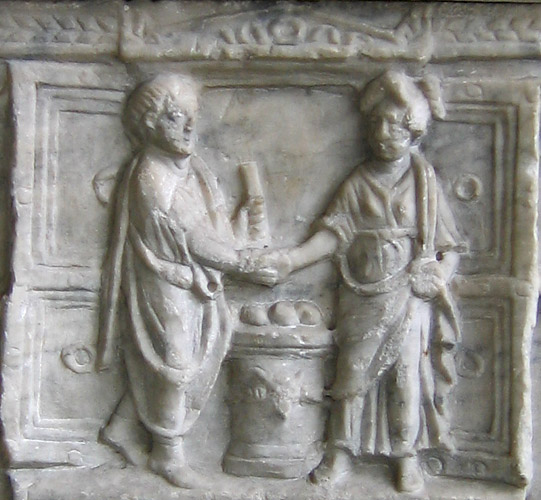
Marble cinerary urn, early 2nd century CE (full monument)
Sextia Psyche, whose name indicates she was a freedwoman of the gens Sextia, dedicated this marble cinerary urn (CIL 6.2317) to Helius Afinianus, whom she proudly identifies as a [servus] publicus (slave of the Roman people), assigned to the Augurs, and as her husband (coniugi). She seems to have commissioned this container herself, intending it for Helius' ashes alone. Psyche's teen-age daughter, her only child mentioned (see CIL 6.2316 below), predeceased Helius; when he died, Psyche was left a widow, presumably the sole survivor of her family, of whose death and burial there is no record. The urn is carved on all sides, in the shape of a temple; its lid is in the form of a pediment whose tympanum contains a relief of an honorary laurel wreath with attached vittae, echoing the temple pediment carved in the relief scene. The corners of the urn on either side of the central panels are carved with figures (a winged Eros standing on a globe on top of a Sphinx) that serve as columns. In the central upper panel is a portrait relief of Psyche and Helius in citizen dress, standing in front of the open doors of a temple with an altar between them, clasping right hands as though in a marriage ceremony. Helius, wearing a toga, holds a scroll in his left hand, either the witnessed marriage contract or his document of manumission; Psyche, dressed as a matrona, also holds something (now broken off) in her left hand, together with the edge of her palla. The letters of the inscription in the lower panel, cut in monumental style, and the opening abbreviation (D • M) suggest a date for the urn no later than early 2nd century CE. This elaborately decorated monument testifies to the couple's wealth and prestige, doubtless resulting from Helius' career as a servus publicus.
The funerary monument for young Vivenia Helias is unfortunately lost, but a record of it survives in CIL 6.2316, where it is described as a small marble base or pedestal, carved with an eagle, a portrait of a young woman whose hair is arranged in "the Sabine style" and two winged boys standing on either side (surely as above), holding torches. The inscription suggests that she was the freeborn and legitimate daughter at her death of Helius Afinianus and Sextia Psyche. Her filiation (L[uci] F[iliae]) indicates that she was freeborn; even if her father was still a slave at her birth and therefore incapable of having a valid marriage (see conubium), Vivenia's status would have followed her freed mother's. That she was the legitimate child of Helius Afinianus is indicated by her second name (Helias, the Greek patronymic meaning "daughter of Helius"), which normally she would have acquired after her father was freed, married her mother, and recognized her as his own through adoption. Although servi publici had high social standing among slaves and freedmen, little is known of their privileges under the law and in practice, which might have included the ability to claim legitimate children before manumission or to retain the title and/or position of servus publicus after manumission.
VIVENIAE • L[uci] • F[iliae] • HELIADI
VIXIT • ANNIS • XVI • MENSIBUS • VII
FECER[unt] • HELIVS • AFINIANUS • PUBLICV[s]
AVGVRVM • CVM • SEX[tia] • PSYCHE • CONIVGE
FILIAE •PIENTISSIMAE
Click on the underlined words for translation aids and commentary, which will appear in a small window.